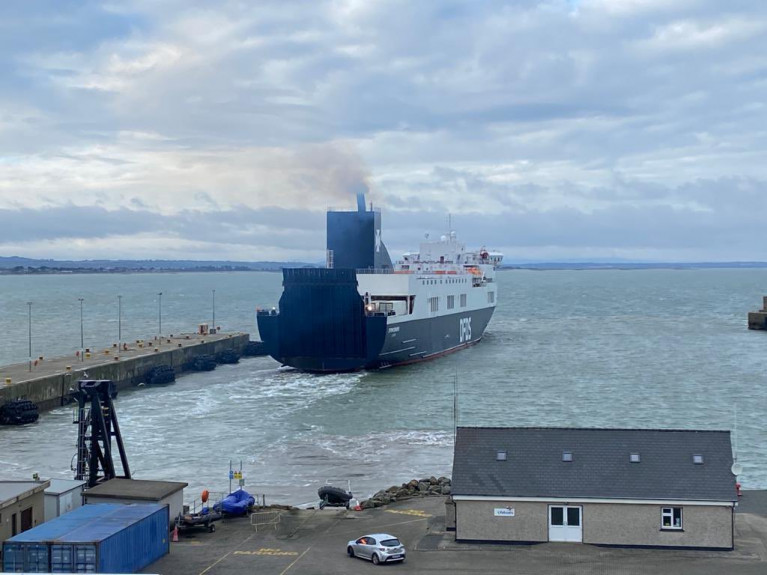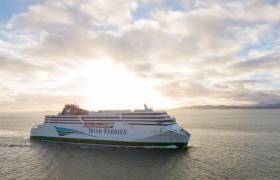Displaying items by tag: Maiden Sailing
Dublin based operator, Irish Ferries saw its cruiseferry Isle of Inishmore this morning set sail on an inaugural sailing from the Port of Dover to Calais in direct competition with P&O Ferries and DFDS.
As Afloat previously reported, tickets went on sale in advance of the new UK-France service, which extends Irish Ferries network of award-winning services. In addition to providing customers with a new operator choice for travelling across the Channel, first announced by ICG in March.
Irish Ferries encourages customers to “sea travel differently” – whether for holidays, business trips, reuniting with loved ones, or planning the road trip of a lifetime. With award-winning hospitality and service, onboard duty-free shopping and extensive amenities to make the journey even more special, the holiday really does begin once passengers’ step onboard.
The Isle of Inishmore has undergone extensive refurbishments for the new service – including an upgraded Club Class Lounge, with spectacular 360-degree sea views, and refreshed, spacious passenger areas. The 90-minute crossing is a breeze, with plenty of amenities onboard. Passengers can avail of free WiFi, re-fuel in Boylan’s Brasserie or Café Lafayette, or let the kids enjoy the soft play area.
With new duty-free allowances post Brexit, it’s the perfect opportunity to stock up in the Duty Free shop, or even plan ahead on purchases, with an innovative, online Click & Collect service. Freight drivers can also enjoy the comfortable facilities including a drivers lounge and dedicated new showers.
Andrew Sheen, Managing Director at Irish Ferries, said: “Our newly-launched route between Dover and Calais brings even more choice for freight customers who can now experience our outstanding service while travelling between the UK and France. We're delighted to bring a little bit of Ireland to this route, and after months of travel limitations, we know that people are very eager to see family and friends, re-ignite business relations, and escape their everyday and take a much-needed holiday. We are in the business of connectivity and want to enable those special memories to be created once travel is permitted again.”
Doug Bannister, Chief Executive of the Port of Dover, said: “We offer a very warm welcome to Irish Ferries and are delighted to see their operations commence from the UK’s busiest international ro-ro port. There has been considerable work by Port of Dover and all parties associated with this new service launch to get prepared for this day, and we are pleased to see all of those efforts come to fruition. We wish Irish Ferries every success for their new venture with us”
Ferry travel makes for a more relaxed holiday option, with the freedom to pack the car with unlimited luggage, bring pets along, and travel exactly where you want in the comfort of your own car. The Flexibility Option from Irish Ferries also offers additional peace of mind if customers need to change bookings at the last minute.
With Irish Ferries ‘Travel Safe’ programme, customers can also travel in confidence; checking in from the security of their own car, sailing with plenty of space in communal areas for natural social distancing onboard, and take in the fresh, sea air from outdoor decks.
Fares start from just £69 for a car and up to nine passengers, and ferries will operate with up to 10 daily crossings.
Maiden Sailing As DFDS Freight RoRo Departs Direct for Dunkirk Bypassing Post-Brexit UK
As Afloat reported earlier today, the maiden sailing of DFDS new freight ferry ro-ro route linking Rosslare Europort and Dunkirk, France on mainland Europe, took place as scheduled this afternoon, writes Jehan Ashmore.
A fully booked Optima Seaways, a 120 freight unit capacity ropax built by Visentini Cantiere Navale, in Italy, departed from the Wexford ferryport at 1400hrs on the near 24 hour route. The ropax was carrying trucks, their drivers and un-accompanied trailers.
The DFDS route offers 6 sailings a week. Such an intense timetable on the new Ireland-France route required two more ropax vessels chartered in by the Danish based operator.
The launch of this ro-ro route, the first to connect these ports, transits through the entire English Channel to Dunkirk on the North Sea. The port's proximity to Paris, the BeNeLux nations and neighbouring Germany provides Irish industry and hauliers alike a vital trading route to markets and avoids the UK land-bridge and associated new post-Brexit scene of customs checks and clearance.
In addition the alternative of this historic new direct freight ferry route avoids crossing both the Irish Sea and notably via the Port of Dover which has endured severe truck congestion recently, partly due to Covid-19 restrictions. Noting, Optima Seaways has single occupancy Covid-19 cabins for truck drivers.
Also previously highlighted on Afloat, was the operators second sailing from Rosslare to Dunkirk which sees Kerry, also of the same 'Visentini' ropax series which is due to depart tonight at 2300.
The final member of DFD freight ferry trio is the fast-ropax Visby, a vessel redeployed from Sweden-Gotland service in the Baltic Sea, and which is to make the first inbound sailing as the Chinese constructed ship is currently at the north France port.
W.B. Yeats Makes Maiden Sailing from Dublin to Holyhead
#ferries - W.B. Yeats has finally made its maiden sailing this morning, as the €147m cruiseferry completed a Dublin-Holyhead crossing by arriving in the Welsh port before lunch-hour, writes Jehan Ashmore.
The impressive 1,885 passenger and crew/300 car/165 truck capacity newbuild ordered by ICG, parent company of Irish Ferries, which was beset with delays at the FSG shipyard in Germany, is now the biggest ever ferry to operate on the Irish Sea.
W.B. Yeats berthed in the Anglesea port though around an hour later than scheduled at 12.20 when Afloat tracked the ship dock in the outer port. This took place in advance of the original scheduled inaugural sailing planned for this Friday. In addition neither did 'freight' only sailings commence as scheduled, which were due to have begun more than a week ago.
This afternoon (14.00) the newbuild is to carry more passengers and freight with the first return leg of the route from Wales.
At around, 51,000 gross tonnage, W.B. Yeats will be a significant boost on the core Irish Sea route, which up till now was served primarily by Ulysses, which is due back in service this Thursday following annual dry-docking. In the meantime, ropax Epsilon also operates having been accompanied by Oscar Wilde, which made its final sailing on the route this morning with an arrival to Dublin Port.
In less than two months time, W.B. Yeats which was also built to serve between Ireland and France will operate the Dublin-Cherbourg route by entering service in mid-March.
Sailings on the direct Ireland-mainland Europe route is to take place just over a fortnight before the UK is due to leave the EU on the 29 March. With vehicle deck space for 2,800 freight lane metres, W.B. Yeats will be vital asset to ensure direct trade links for hauliers with an alternative of the UK landbridge and in whatever Brexit scenario arises.
As for passenger facilities, among them is the the Maud Gonne Bar & Lounge, Innisfree Club Class Lounge, The Hazel Wood Quiet Lounge and The Abbey & The Peacock Cinema & Lounge.
Accommodation comprises 440 cabins and of the luxury suites they feature a balcony along with a dedicated butler service. This feature will be particularly suited for the longer sea journey between the Irish capital and Normandy.
W.B. Yeats Remains to Enter 'Freight' Service In Advance of Looming Passenger Debut
#ferries - Once again W.B. Yeats first scheduled sailing albeit freight-only on the Dublin-Holyhead route has been deferred, it was meant to begin today with a morning sailing bound for the Welsh port, writes Jehan Ashmore
The Irish Ferries freight website lists the W.B. Yeats instead with a departure from Dublin Port next week, Monday, (21 January) on the 20.55 crossing to Holyhead, with an arrival in Anglesey on the Tuesday, just after midnight at 00.10hrs.
As highlighted before, W.B. Yeats first sailing originally timetabled was to have taken place almost a week ago on 13 January. Currently maintaining services is Oscar Wilde and Epsilon.
If the new €147m cruiseferry does carry out this first maiden commercial sailing on Monday, it would be held in the same week when sailings are to accommodate 'passengers'. As Irish Ferries previously confirmed to Afloat.ie, W.B. Yeats inaugural passenger and freight service is scheduled for next Friday (25 January) departing Dublin in the early hours at 02.00.
W.B. Yeats to Make Maiden Sailing (Freight-Only) This Sunday
#ferries - Irish Ferries new cruiseferry W.B. Yeats is finally to enter service by making a maiden commercial sailing on the Dublin-Holyhead route this Sunday, albeit the giant ship will only take freight vehicles and drivers, writes Jehan Ashmore.
According to the operator's freight website, the first sailing to be operated by W.B. Yeats is from Dublin Port on January 13th with a scheduled departure time of 20.55hrs. The €147m cruiseferry of around 51,000 gross tonnage can handle 1,200 vehicles, is to sail the core Irish Sea crossing with an arrival time in the north Wales port the next day at 00.10hrs.
The first full service including passengers is to take place later this month as previously reported on Afloat.ie, when the 1,885 passenger and crew capacity cruiseferry departs the Irish capital on Friday, 25th January. On the occasion of this maiden crossing, however the sailing is to depart in the early hours at 02.00hrs.
The debut of WB Yeats which has 440 cabins, will see the ship take over the routine sailing roster of Ulysses. The 2001 built ferry is to undergo an annual dry-docking, leaving Oscar Wilde to maintain sailings based on carrying both passengers and freight.
Before this take place, as a matter of reflection it is almost a month since W.B. Yeats docked in the Irish capital for the first time, having made a delivery voyage from Germany..
The shipyard, Flensburger Schiffbau-Gesellschaft located in Flensburg was beset with delays in completing the 194m long newbuild. The delays FSG cited were due to the delivery of interior components for public areas and electrical systems installed in the hull and deckhouse.
After months behind schedule, which led to cancellation of thousands of high-season holidays makers booked on the Dublin-Cherbourg route, W.B. Yeats will now first enter service instead on the Ireland-Wales route. It was originally planned to have the new ferry take up this service in September following the end of last year's summer sailings on the Dublin-Cherbourg route.
As for the French connection, Irish Ferries have given a mid-March date for the launch on the direct route to continental Europe.
































































